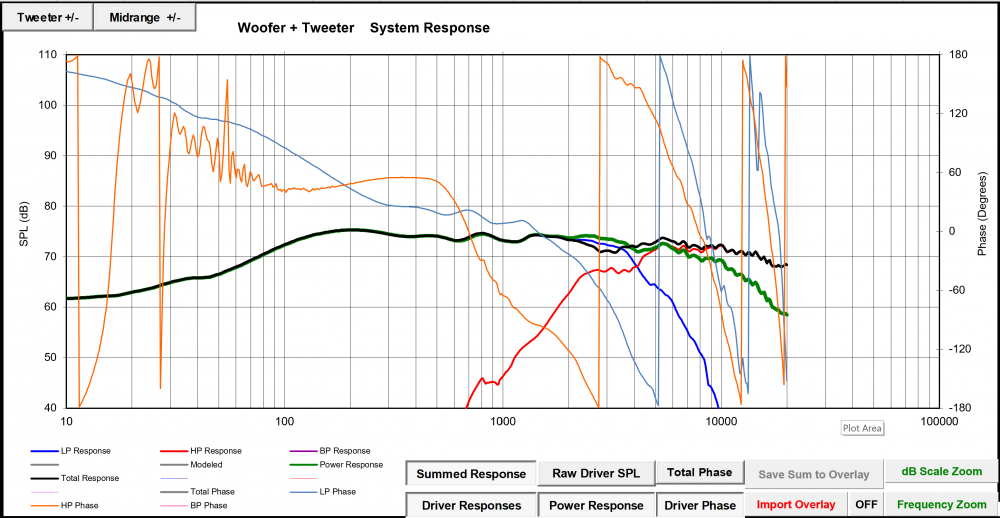Site Links
Howdy, Stranger!
It looks like you're new here. If you want to get involved, click one of these buttons!
Quick Links
Categories
In this Discussion
Who's Online (0)
Power Response VS Summed Response
What should we optimize for - power response or summed response.
While playing in PCD, i came across the following scenario - The power response seems to be higher than the summed response. The summed response is lower than the woofer response - indicate a little bit of cancellation from the tweeter.
Usually I see a dip in the power response around the XO region, but in this case i see the opposite - the Power response is flat compared to the summer response.
The Phase seems to have gone for a toss... inverting the tweeter doesn't seem to do much to the summed or power response - slightly wonky wobble, but nothing more. Trying to get the woofer and tweeter phase to overlap or even come close seems to destroy anything on the summed or power response - so this is probably going to get thrown away and started from scratch. But i wanted to understand power response and summed response what what should be prioritized over what?
The woofer is forth order parallel with a parallel LR Contour filter and tweeter is third order parallel.

While playing in PCD, i came across the following scenario - The power response seems to be higher than the summed response. The summed response is lower than the woofer response - indicate a little bit of cancellation from the tweeter.
Usually I see a dip in the power response around the XO region, but in this case i see the opposite - the Power response is flat compared to the summer response.
The Phase seems to have gone for a toss... inverting the tweeter doesn't seem to do much to the summed or power response - slightly wonky wobble, but nothing more. Trying to get the woofer and tweeter phase to overlap or even come close seems to destroy anything on the summed or power response - so this is probably going to get thrown away and started from scratch. But i wanted to understand power response and summed response what what should be prioritized over what?
The woofer is forth order parallel with a parallel LR Contour filter and tweeter is third order parallel.

Comments
So given that this sim is not that - how viable is this particular sim - usable or shouldn't be considered at all. As I am getting good phase overlap with deep reverse null, but at a cost of a smooth summed / power response. So what is more important / desirable smoother FR with not so good phase integration or slightly bumpy FR but with better phase response?
My Limus design had OK phase alignment, and I thought decent off axis performance. But I got comments that it sounded hot. I discovered a big lobe vertically off axis.
V3, this is not that close, but the Summer response is relatively flat and the Rev null has a deeper null.
V4, little dip in 5k and shallower rev null
Place a cap across your padding resistor of about 1-2uF to lift top octave.
InDIYana Event Website
Looks like you might have some impedance issues to work out.
haven't played around with impedance much - what's the process for bumping up impedance...
Would that be R10 in PCD, and would the Cap be C8?
The dip at 4k is around 3db and 5 db for the power response, but the phase and reverse null is pretty good. The impedance stays around 4 ohms throughout, so that's good - see next post...
I think I will start with this and see how it measures once I have the XO put together.
Summed Response, Transfer Function and Impedance.
Impedance stays at/above 4ohms.
Tweeter in Reverse:
Woofer Low Pass:
Tweeter High Pass: